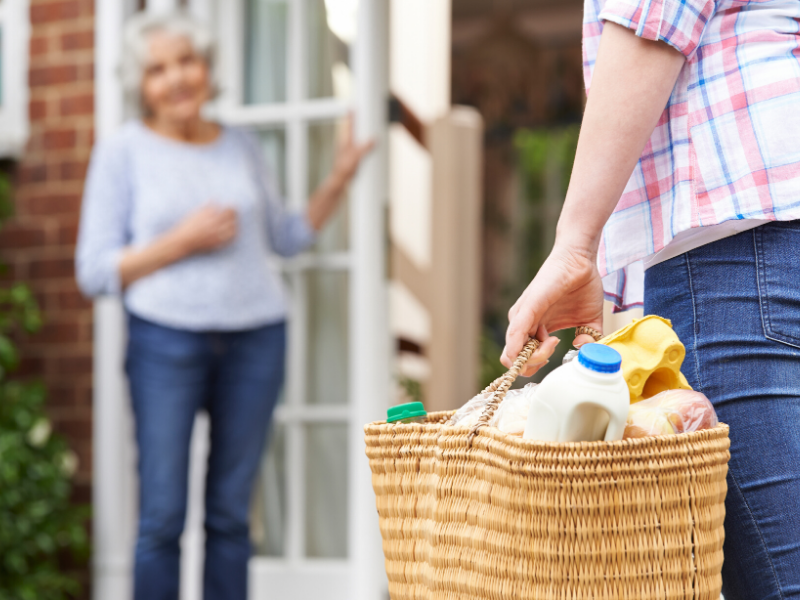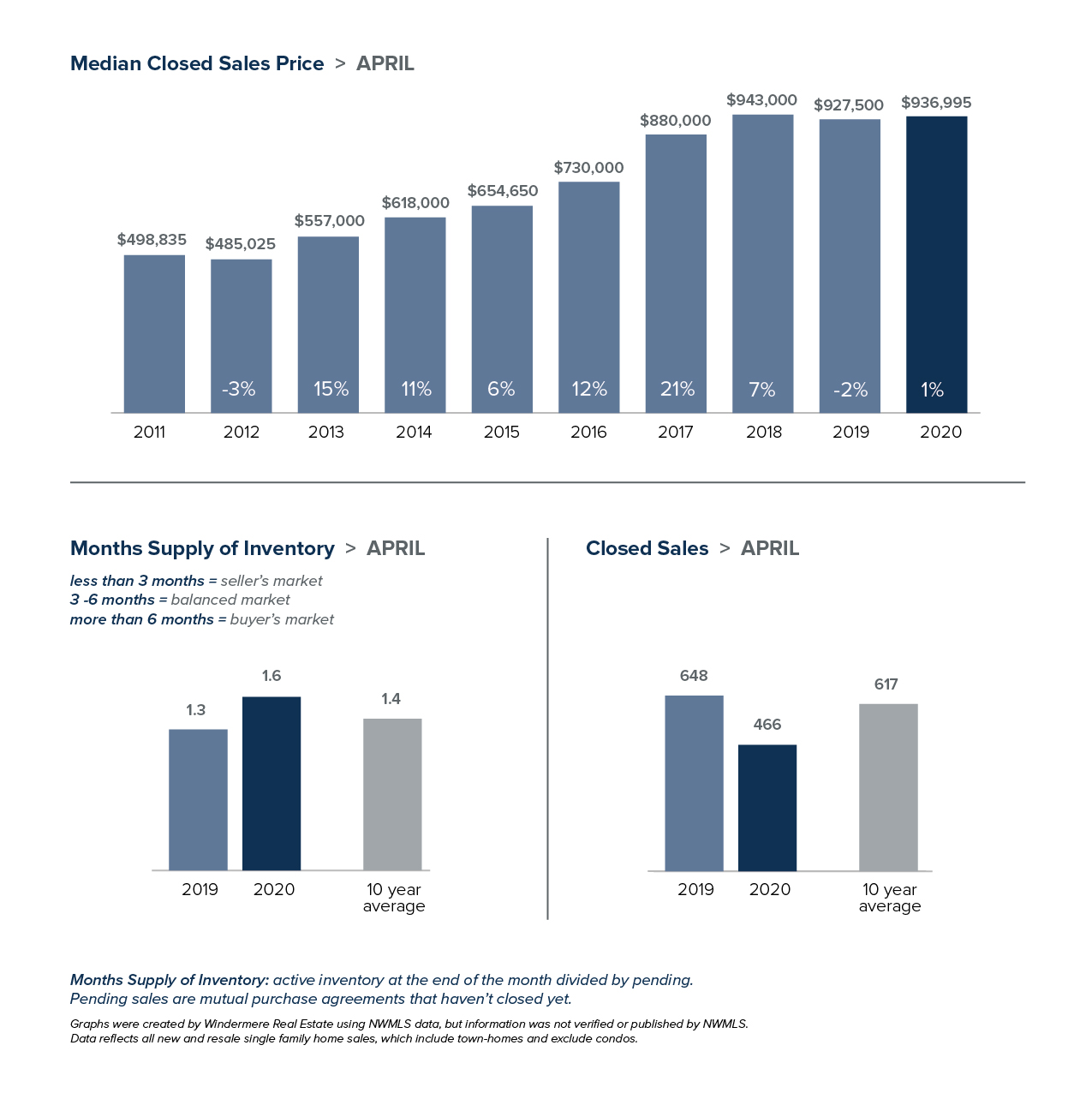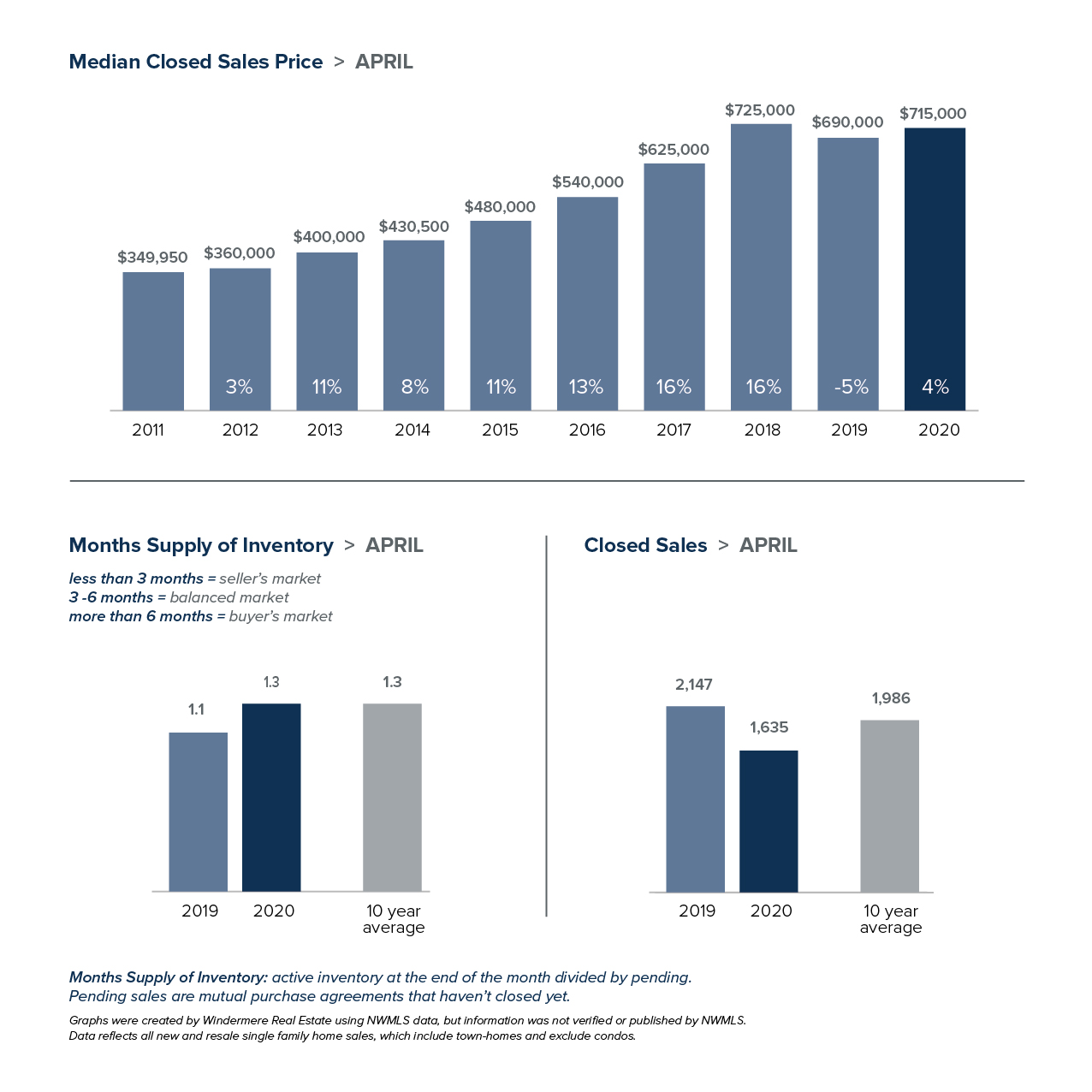Local Market Update – May 2020


We hope you are weathering the new normal as best as you can. With everyone spending more time than ever at home, real estate has taken on a whole new importance. For those who are interested, here is a brief update on how COVID-19 continues to affect our local market:
- Business was better than expected under the Stay Home order. COVID-19 did reduce real estate sales in April as compared to a year ago, however the number of sales rose steadily each week of the month. Sales growth continued in early May and we expect sales to increase slowly week by week.
- The number of new listings dropped, suggesting that would-be sellers are waiting until the shelter-in-place order is over to put their home on the market. With local technology companies continuing to hire, buyers will continue to face competition for limited inventory in the coming months.
- Home prices remain stable, with the median price of homes sold in April up slightly from a year ago. Sellers appear to be pricing homes realistically and buyers are not finding deep discounts.
The monthly statistics below are based on closed sales. Since closing generally takes 30 days, the statistics for April are mostly reflective of sales in March. Next month’s data will offer a more telling trend of the effect of the virus on the local housing market.
If you are interested in more information, every Monday Windermere Chief Economist Matthew Gardner provides an update regarding the impact of COVID-19 on the US economy and housing market. You can get Matthew’s latest update here.
As our current situation evolves, know that the safety of everyone remains our top priority.
EASTSIDE
KING COUNTY
SEATTLE
SNOHOMISH COUNTY
VIEW FULL SNOHOMISH COUNTY REPORT
This post originally appeared on GetTheWReport.com
All In, For Community Amid COVID-19


Image Source: Shutterstock
Over the past few weeks, as the effects of COVID-19 have spread to everywhere Windermere has offices, we have seen an outpouring of support from our agents and offices in their local communities, embodying what it means to be All In, For You.
The Bellevue, WA-based Windermere Real Estate East Inc. offices have been all in for their community in recent weeks by organizing “Feed the Front Lines.” This effort has raised upwards of $9,000, with many members volunteering their time to help pick-up and deliver much-needed meals to the medical professionals at a local hospital. So far, they have scheduled six shifts of lunch and dinner deliveries, totaling 415 meals. They have reached out further into the community, collecting donations for local small businesses that have been forced to close.

A flyer for “Feed the Front Lines”
Windermere agent Chris Gaines—based in Boise, Idaho with the Windermere Powerhouse Group—was inspired to deliver food and other necessities to the elderly in his neighborhood. Chris and his family spent the day visiting local grocery stores and gathering supplies to make care packages. After divvying everything up, they safely delivered the care packages to neighbors, who were sincerely grateful. “It was clear by the excitement of some of them that we were the first to have visited since all of this began,” said Chris of his neighbors.

Chris’s daughters delivering supplies to a neighbor
In other cities where Windermere operates, such as Palm Springs, agents are volunteering to buy and deliver groceries for the local elderly population who are currently unable to leave home due to the threat of COVID-19.
On Maui, the local Windermere office is routing Windermere Foundation donations to a local food bank. On top of that, they will provide that same food bank with a donation from each closed home sale over the next 60 days. Agents on Maui are also volunteering to prepare grab-and-go breakfast and lunch meals for kids at the Kihei Charter School.

The team in Maui, HI
In Nevada, the mother-son team of Reba St. Clair & Devone Donley are providing delivery services free of charge to their neighbors throughout the Lake Las Vegas area. They are picking up prescriptions and performing food deliveries, making themselves a dependable resource to their community.

Reba & Devone’s community flyer
The Seattle-area offices that make up Windermere Wall Street recently donated $2,000 to Refugee Artisan Initiative (RAI) to aid in the supply of personal protective equipment (PPE), such as surgical masks. RAI’s mission is to transform the lives of refugee and immigrant women by providing sustainable work in sewing and handcrafting goods.
As our agents and offices have proven time and time again, together we can make a difference. We will continue to share these uplifting stories of support for our communities through the COVID-19 pandemic.
All In, For Community. All In, For You.
This post originally appeared on the Windermere.com Blog
Simple Steps for Maintaining Air Quality in Your Home


Most of us tend to think of air pollution as something that occurs outdoors where car exhaust and factory fumes proliferate, but there’s such a thing as indoor air pollution, too. Since the 1950s, the number of synthetic chemicals used in products for the home has increased drastically, while at the same time, homes have become much tighter and better insulated. As a result, the EPA estimates that indoor pollutants today are anywhere from five to 70 times higher than pollutants in outside air.
Luckily, there are many ways to reduce indoor air pollution. We all know that buying organic and natural home materials and cleaning supplies can improve the air quality in our homes, but there are several other measures you can take as well.
How pollutants get into our homes
Potentially toxic ingredients are found in many materials throughout the home, and they leach out into the air as Volatile Organic Compounds or VOCs. If you open a can of paint, you can probably smell those VOCs. The “new car smell” is another example of this. The smell seems to dissipate after a while, but VOCs can actually “off-gas” for a long time, even after a noticeable smell is gone.
We all know to use paint and glue in a well-ventilated room, but there are many other materials that don’t come with that warning. For instance, there are chemicals, such as formaldehyde, in the resin used to make most cabinets and plywood particle board. It’s also in wall paneling and closet shelves, and in certain wood finishes used on cabinets and furniture. The problems aren’t just with wood, either. Fabrics—everything from draperies to upholstery, bedding, and carpets—are a potent source of VOCs.
The good news about VOCs is that they do dissipate with time. For that reason, the highest levels of VOCs are usually found in new homes or remodels. If you are concerned about VOCs, there are several products you can buy that are either low- or no-VOC. You can also have your home professionally tested.
How to reduce VOCs in your home
Make smart choices in building materials.
- For floors, use tile or solid wood—hardwood, bamboo, or cork – instead of composites.
- Instead of using pressed particle board or indoor plywood, choose solid wood or outdoor-quality plywood that uses a less toxic form of formaldehyde.
- Choose low-VOC or VOC-free paints and finishes.
Purify the air that’s there.
- Make sure your rooms have adequate ventilation, and air out newly renovated or refurnished areas for at least a week, if possible.
- Clean ductwork and furnace filters regularly.
- Install air cleaners if needed.
- Use only environmentally responsible cleaning chemicals.
- Plants can help clean the air: good nonpoisonous options include bamboo palm, lady palm, parlor palm, and moth orchids.
- Air out freshly dry-cleaned clothes or choose a “green” cleaner.
Fight the carpet demons.
- Choose “Green Label” carpeting or a natural fiber such as wool or sisal.
- Use nails instead of glue to secure carpet.
- Install carpet LAST after completing painting projects, wall coverings, and other high-VOC processes.
- Air out newly carpeted areas before using.
- Use a HEPA vacuum or a central vac system that vents outdoors.
Prevent Mold.
- Clean up water leaks fast.
- Use dehumidifiers, if necessary, to keep humidity below 60 percent.
- Don’t carpet rooms that stay damp.
- Insulate pipes, crawl spaces, and windows to eliminate condensation.
- Kill mold before it gets a grip with one-half cup of bleach per gallon of water.
I hope this information is helpful. If you would like to learn more about VOCs and indoor air quality, please visit http://www.epa.gov/iaq/.
This post originally appeared on the Windermere.com Blog
Impact of the Coronavirus on the U.S. Housing Market


The Coronavirus (COVID-19) has caused massive global uncertainty, including a U.S. stock market correction no one could have seen coming. While much of the news has been about the effect on various markets, let’s also acknowledge the true impact it continues to have on lives and families around the world.
With all this uncertainty, how do you make powerful and confident decisions in regard to your real estate plans?
The National Association of Realtors (NAR) anticipates:
“At the very least, the coronavirus could cause some people to put home sales on hold.”
While this is an understandable approach, it is important to balance that with how it may end up costing you in the long run. If you’re considering buying or selling a home, it is key to educate yourself so that you can take thoughtful and intentional next steps for your future.
For example, when there’s fear in the world, we see lower mortgage interest rates as investors flee stocks for the safety of U.S. bonds. This connection should be considered when making real estate decisions.
According to the National Association of Home Builders (NAHB):
“The Fed’s action was expected but perhaps not to this degree and timing. And the policy change was consistent with recent declines for interest rates in the bond market. These declines should push mortgage interest rates closer to a low 3% average for the 30-year fixed rate mortgage.”
This is exactly what we’re experiencing right now as mortgage interest rates hover at the lowest levels in the history of the housing market.
Bottom Line
The full impact of the Coronavirus is still not yet known. It is in times like these that working with an informed and educated real estate professional can make all the difference in the world.

 Facebook
Facebook
 Twitter
Twitter
 Pinterest
Pinterest
 Copy Link
Copy Link









